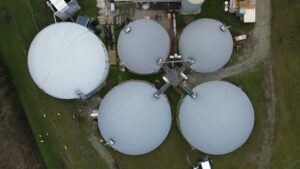

Decoding Labour's Renewable Energy Roadmap
The Labour government’s ambitious energy transition program, aiming for a zero-carbon electricity system by 2030, presents new opportunities for renewable energy developers in the UK but what opportunities? In this article, we tr getting closer to the answer by decoding Labour’s renewable energy roadmap.
Table of Contents
GB Energy to the rescue?
In Labour’s renewable energy roadmap, the most significant piece is the proposed Great British (GB) Energy, Labour’s flagship £8.3 billion public energy company that is to focus on renewable energy technologies and accelerate the commercialization of the sector.
GB Energy will be established using state funds. Rather than directly supplying electricity to households, its primary function will be to collaborate with private sector entities in co-investing in emerging clean energy technologies, and partner with local authorities and energy communities to expand smaller-scale renewable energy projects. Profits will be reinvested in the company.
For established developers, GB Energy presents opportunities for public-private partnerships, and to compete in areas traditionally dominated by the private sector. The government’s targets – quadrupling offshore wind, tripling solar, and doubling onshore wind capacity by 2030 are aggressive, even by global standards. To help, Labour proposes regulatory reforms that include the designation of large wind farms as nationally significant infrastructure projects. This change, reverting to pre-2015 approval mechanisms, may streamline consent processes and accelerate project timelines. Two other proposals also signal Labour’s commitment to clean energy:
- The proposed National Wealth Fund, a £7 billion strategic investment vehicle is set for immediate establishment with a five-year spending timeline to invest funds across key sectors: £1.8 billion for port infrastructure, £1.5 billion for gigafactories, £2.5 billion for clean steel production, £1 billion for carbon capture, and £500 million for green hydrogen.
- The Contracts for Difference (CfD) scheme has increased the budget for renewable energy auctions to £1.5 billion, a £500 million boost from the previous year.
Along with the overturning of the onshore wind ban in England, these initiatives open up significant development opportunities even whilst they raise questions about grid capacity and the pace of necessary infrastructure upgrades. Crucially, Labour does acknowledge grid connection issues. The proposed Future Systems Operator (now known as the National Energy System Operator, NESO) addresses some long-standing industry needs for expedited decision-making on renewable proposals. It streamlines the approval process for renewable projects, aiming to reduce decision-making timeframes from years to months. NESO is meant to coordinate regional and national infrastructure planning, reform the planning system, and shift to a ‘first-ready, first served’ model for grid capacity allocation that could reduce project timelines and costs and provide a coordinated approach to grid development.
Also an opportunity is the government’s emphasis on sustainability and biodiversity in new developments, which aligns with growing investor expectations. For renewable energy development companies, the key will be taking advantage of these policy changes to secure faster and more committed capital for greenfield projects.
Regulatory sea change for onshore wind
The Labour government’s swift action to remove the de facto ban on onshore wind eliminates stringent 2015 planning tests and opens up significant opportunities for developers, who have been largely confined to Scottish projects for nearly a decade.
The stark contrast in onshore wind development between England and Scotland since 2015 underscores the potential for growth. England saw a 97% reduction in wind turbines granted planning permission from 2016–2021 compared to 2009–2014. Conversely, Scotland has dominated new capacity, accounting for 93% of onshore wind submissions since 2016. The removal of restrictive footnotes from the National Planning Policy Framework (NPPF) effectively places onshore wind on equal footing with other renewable energy proposals. This change signals a more favorable environment for developers, potentially unlocking a significant pipeline of projects that have been in stasis.

Strategizing for the UK's solar renaissance
Labour has placed solar photovoltaic (PV) technology at the forefront of the UK’s clean energy transition. With a commitment to triple solar capacity by 2030, equivalent to scaling the UK’s generation capacity to 42GW, the sector is poised for significant expansion across utility-scale, commercial, and residential installations.
The recent granting of Development Consent Orders (DCOs) for three solar-based Nationally Significant Infrastructure Projects (NSIPs) totaling over 1.3GW demonstrates the government’s commitment to large-scale solar deployment. The Gate Burton (500MW) and Sunnica (500MW) projects, both incorporating energy storage, and the Mallard Pass (350MW) development represent a step-change in the scale of individual solar farms in the UK. These projects join the 373MW Cleve Hill solar farm under construction in Kent and the 420MW Longfield project in Hertfordshire, which received consent last year. This pipeline of gigawatt-scale projects signals a maturing market for utility-scale solar, presenting opportunities for developers with the capacity to navigate complex planning and grid connection processes.
While utility-scale projects dominate headlines, the government’s forthcoming plans to boost rooftop solar also present significant opportunities in the commercial and residential sectors. The UK’s current installed capacity of 17GW, according to government data, with about one-third from rooftop installations, suggests considerable room for growth. The contrast with Germany, which added 14.1GW of solar capacity in 2023 alone, highlights the UK market’s growth potential.
Energy Secretary Ed Miliband’s vision for a UK ‘solar rooftop revolution’ indicates potential policy support for widespread adoption. Developers and installers should prepare for increased demand, particularly if incentives are introduced to encourage builders and homeowners to integrate solar PV systems. GB Energy, with its aim to catalyze investment in clean energy technologies, potentially de-risks projects and suggests a more favorable environment for solar investments. And the proposed requirement for FTSE 100 companies to implement transition plans aligned with the Paris Agreement’s 1.5°C goal may drive corporate demand for solar installations.
BESS: Bridging the gap between promise and practice
The UK’s Battery Energy Storage Sector (BESS) is experiencing rapid growth, with operational capacity reaching 4.4GW by early 2024. The total pipeline of battery projects has surged to 95GW, marking a 67.4% increase from the previous year. This growth reflects strong investor confidence in the sector, with the average size of projects seeking planning permission increasing significantly from 27MW in 2019 to 80MW today.
The new Labour government has recognized the critical role of energy storage in achieving their ambitious clean energy targets. They have pledged to fully decarbonize the power system by 2030, a goal that relies heavily on the expansion of battery storage capacity, but will only be reached if the grid improves. Fast.
GB Energy will be part of Labour’s plans to accelerate investment in battery storage projects, and the government also has plans to address key challenges facing the BESS sector, such as grid connection delays and planning hurdles. Especially the grid is hurting the deployment of more BESS, and it’s giving many BESS developers something to think about. Speaking to an Ofgem representative at the 2024 Eastern European Energy Storage Summit in Warsaw, we were told that some developers, depending on the area, are currently receiving grid connection dates sixteen years from now, which strongly underlines the state of the current grid and the need for upgrades.
They have committed to reforming the planning system to expedite approvals for renewable energy projects, including battery storage. Labour’s plans to increase the budget for renewable energy auctions to £1.5 billion may also benefit BESS projects co-located with renewable generation sites.
Positioning for success
As Labour’s ambitious renewable energy agenda unfolds, UK developers face a landscape rich with opportunity yet fraught with complexity. The interplay of public investment, regulatory reform, and technological advancement demands a recalibration of business strategies. Success may hinge on agile adaptation to evolving policy frameworks, proactive engagement with grid integration challenges, and innovative approaches to project financing and partnerships. Those who can effectively navigate this environment and blend technical expertise with strategic foresight and investment partners will be positioned to thrive.

